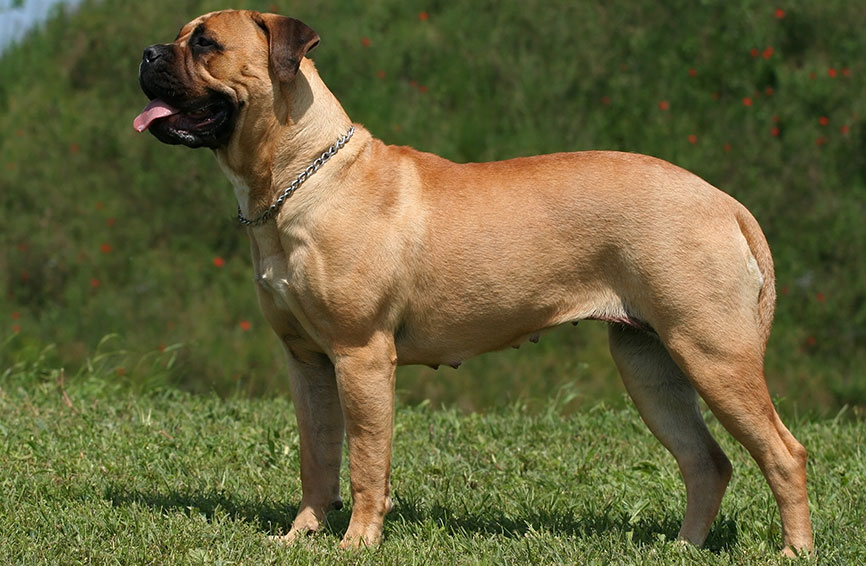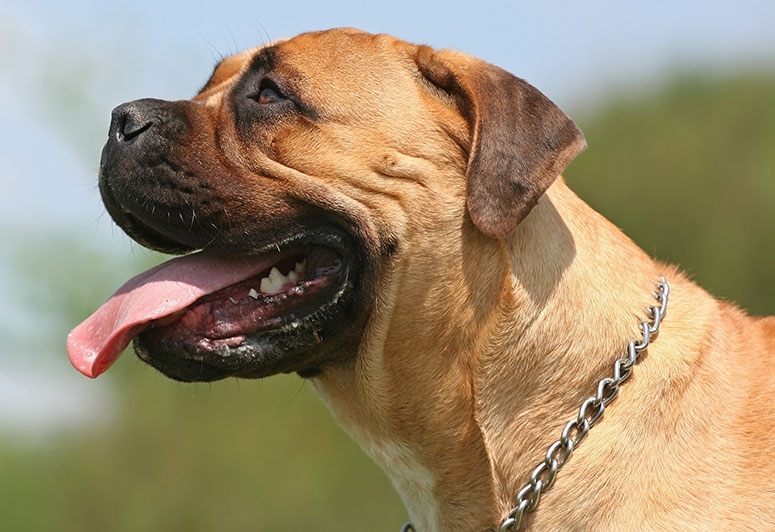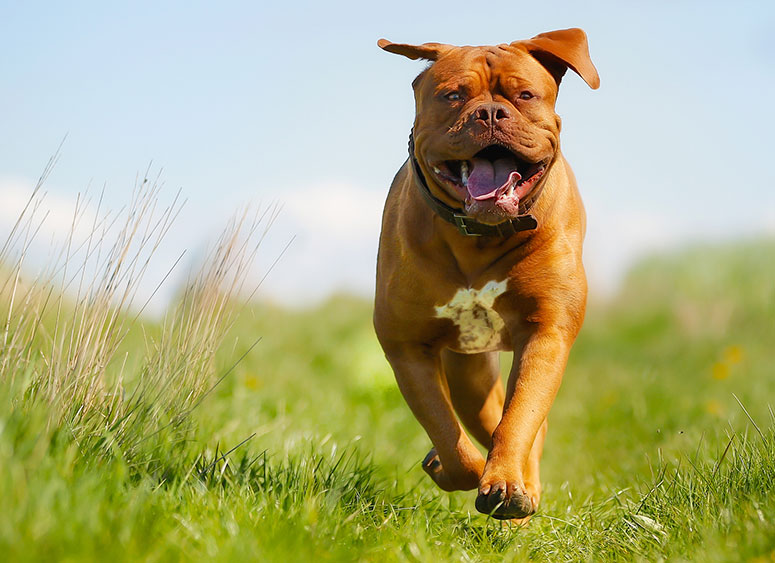Table of Contents
Introduction to Mastiffs
Among the largest dog breeds that exist in the world is the mastiff, a working group dog that is good-natured and courageous. These massive dogs have a long history that dates back to ancient times. They can outweigh fully-grown human adults and are distinguishable by their broad heads and muscular bodies. Mastiffs have a formidable appearance but they are also very kind and lovable dogs that are protective of their family members and a wonderful addition to many households.
If bringing a huge dog with lots of love to give into your life sounds amazing, then read on to learn more about the mastiff breed and how to take the best care of a mastiff’s health.
Size of Mastiffs
The most defining characteristic of a mastiff is its size, as these dogs can grow to weigh up to 230 pounds as males and 170 pounds as females. The average weight range for an adult male mastiff is 160 to 230 pounds, while the female range is 120 to 170 pounds. Male mastiffs can stand 30 inches tall or more at the shoulder, and females are at least 27.5 inches tall when fully grown.
Here’s how big you can expect your mastiff to get during the first year of life:
| Weight Chart | 3 months | 6 months | 9 months | 12 months |
| Male mastiffs | 45-60 lbs. | 80-110 lbs. | 110-170 lbs. | 150-200 lbs. |
| Female mastiffs | 30-50 lbs. | 60-90 lbs. | 95-125 lbs. | 110-160 lbs. |
Interestingly, a mastiff can continue growing for several years, which is considerably longer than many other dog breeds. Mastiffs continue gaining weight after their first year, although the rate of growth does slow down after the 12-month mark.
Characteristics of Mastiffs
Mastiffs were once known as vicious dogs that were ready to fight in battle and help win wars. But today’s modern mastiff is much gentler and more manageable as a household member. They are known for being gentle and affectionate with their family but can need a little time to warm up to strangers.
Because of a mastiff’s size, this dog should not typically live in an apartment or other small space. This is also not the best dog for a first-time pet parent because they can be challenging to handle due to their immense strength and power. Mastiffs do better in cool weather than hot weather, and although they are wary towards strangers, they are very affectionate with people they know.
As you get to know a mastiff’s personality, here’s what you can expect based on his or her breed characteristics.
| Breed Characteristic | Level (High, Medium, Low) |
| Affectionate with People | Medium |
| Good with Kids | High |
| Good with Pets | Medium |
| Need for Exercise | Medium |
| Energy Level | Medium |
| Intelligence Level | Medium |
| Able to Be Trained | Medium |
| Amount of Barking | Medium |
| Amount of Shedding | Medium |
Mastiff Standard Information
Aside from the mastiff’s impressive size, there are other defining physical characteristics by which these dogs are judged at shows and competitions. For example, the dogs are symmetrical with a well-knit frame, have a proportionately powerful structure, and have a somewhat rectangular shape.
Here is an overview of the breed standard information for mastiffs:
Head:
- Eyes set wide apart and medium in size
- Alert and kind expression
- Ears V-shaped and rounded at tips
- Broad and somewhat flattened skull between ears
- Muzzle half the length of the skull
- Scissors bite preferred but moderately undershot jaw acceptable
Neck, Topline, Body:
- Powerful, muscular and slightly arched neck
- Tail set moderately high and wide at root, tapering toward end
- Broad, wide, and muscular hindquarters
Forequarters:
- Moderately sloping, powerful, and muscular forequarters
- Large, round, and compact feet
- Black nails preferable
Hindquarters:
- Broad, wide, and muscular hindquarters
- Rear legs that are wide apart and parallel
Coat:
- Straight, coarse, and moderately short
- Dense and short undercoat
Color:
- Brindle, apricot, or fawn
- Dark muzzle, ears, and nose
- Small white patch on chest is permitted
Gait:
- Rear legs have drive while forelegs track smoothly
- Movement of power and strength
Caring for Mastiffs
Mastiffs are pleasant to care for because they are calm and peaceful. They truly are gentle giants, but they can be stubborn and challenging to handle if they aren’t properly trained and socialized. These are not dogs to be left tied up in a yard as a warning sign to potential intruders. They are protective dogs, but they also crave family time and can get bored easily, leading to destructive behavior.
Here are some general tips for taking the best care of a mastiff:
Best Living Environments:
- Houses with large, fenced yards
- No apartments
- Usually good with kids of all ages
Type of Exercise:
- Moderate exercise needs
- Two 30-minute walks per day
- Not good jogging companions due to joint stress and overheating
- Walk in the morning and evening when it’s cooler outside
Mental Enrichment:
- Curious dogs so keep them busy with toys
- Provide dog with chew toys to positively channel chewing energy
- Crate training is recommended to prevent destructive behaviors
Training Strategies:
- Known for being stubborn
- Keep human food out of reach
- Obedience training from puppyhood
Grooming Tips:
- Brush teeth daily
- Trim nails as needed if not worn down naturally
- Check ears weekly for redness and odor
- Brush coat weekly with a brush or rubber hound glove
Common Health Problems of Mastiffs
Large dog breeds typically have shorter life spans than smaller dogs, and the mastiff is no exception to this rule. The average life span of a mastiff is six to 10 years. There are certain conditions that are important to pay attention to if you have a mastiff in your life in order to help your dog live the longest and healthiest life possible. You can also take the best possible care of your mastiff and get your dog the necessary treatment by enrolling your pup in Healthy Paws pet insurance from an early age.
These are some of the most common health issues that arise with mastiffs:
- Progressive retinal atrophy and other eye problems
- Hip dysplasia
- Elbow dysplasia
- Several types of heart disease
- Cystinuria (inherited kidney defect)
- Gastric torsion (bloat)
- Hypothyroidism
- Degenerative myelopathy
- Patellar luxation
- Cancer
Diet and Nutrition for Mastiffs
Most adult dogs will thrive when eating a high-quality, nutritionally complete and balanced dog food. Mastiff puppies should generally eat a large breed puppy food until they are around 18-24 months old. If you feed your mastiff homemade dog food, make sure you are working from a recipe that is designed by a veterinary nutritionist and is appropriate for your dog’s age and health status.
Feed the amount of dog food needed to keep your pet slim. You should be able to see your dog’s waist and feel (but not see) their ribs without having to press too hard. In general, puppies need more calories per day than adults, but a dog’s needs will vary with his or her activity level and other factors. Don’t leave food out all day for a mastiff to graze on. Divide the total amount of food for the day into two or three meals for adults and at least three meals for puppies. Place the food out in a bowl at approximately the same time in the morning and evening each day.
Talk to your veterinarian if you have any questions about your mastiff’s diet or health.
Where to Adopt or Purchase Mastiffs
Although mastiffs are purebred dogs, you can find them at shelters and from rescue organizations because people often buy them without realizing what it takes to care for such a large dog. The Mastiff Club of America is the national parent club for the breed and has a breeder referral program and breeder groups to learn about. There are also regionally specific rescue organizations that are dedicated to finding dogs of this breed loving homes, such as Southern States Mastiff Rescue, Mastiff to Mutts Rescue, and Happy Go Lucky Mastiff Rescue.
Related Breeds
If you love the mastiff dog, there are a few different breed options to choose from. Although they all share similar characteristics (muscular, huge, majestic, protective), there are also some differences too.
These are some of the other types of mastiffs that you may find for purchase or adoption:
- Bullmastiff
- Neapolitan mastiff
- Tibetan mastiff
- English mastiff
- Anatolian mastiff
- American mastiff
Pet Insurance for Mastiffs
Mastiffs require an extra dose of love and care to ensure that they are happy and living their best lives. When you have a mastiff, it is important to have a pet insurance plan that you can rely on when your pup has an accident or is diagnosed with a genetic condition, breed-specific condition, cancer, or other illness. Healthy Paws covers emergencies, alternative care, and treatment from any licensed vet you choose.
We are here for you and your mastiff when times get tough and you need a little help paying for expensive vet bills. Get your mastiff pet insurance quote on our website today and enjoy more amazing days with the gentle giant that has become your new best friend.













